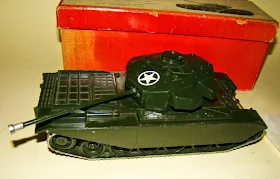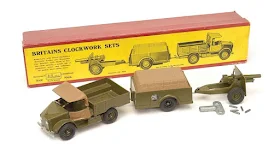To today’s toy soldier collectors, particularly those who
are dioramists, consistency of scale, i.e. size, has become almost an obsession.
Many individuals have, and are, using it as a primary buy/don’t buy criterion,
regardless of the accuracy, level of detail, or quality of the figure, vehicle, or aircraft under consideration. On the various toy soldier forums I participate in there is almost a continuous series of discussions on the subject, which frequently get rather contentious, to put it mildly. Not only will people conduct a detailed comparison of models versus the real thing by mark and mod, but will compare the efforts of the various manufacturers, as to how accurately they have replicated the actual tank or truck in scaled size. This is compounded by the fact that today not just 1:32 scale is being used, but 1:30 scale as well. In addition there are individual manufacturer's variances/interpretations of each of these scales, some intentional and others through apparent lack of in-depth research. It is amazing how much difference there is between a figure or vehicle of 54mm (1:32) and 60mm (1:30), a mere 6mm.
That was not always that case. As a classic example, W.
Britains Ltd. produced an entire series of trucks which were based on a composite
design of a Commer Q4 lorry and a Morris
LC5 lorry, both extensively used by the British Army in World War II. These
included Sets No. 1334, 1335, 1433, 1512, 1513, and 1641 Although the vehicles were of various
configurations, they featured a common “bonnet” (hood/front end) and cab design of
identical dimensions. In addition the post-WWII Britains revised design,
introduced in 1946, appears to be a lorry from that year rather than from the actual
period of the war years (1939-1945). In the final configuration there is a slight, but discernible, elongation of the bonnet dimension, as well as a revised front end configuration. Somehow, while Britains were still
considered toy soldiers, the matter of scale was not an issue of any
consequence, and did not appear to impact either popularity or sales volume. I do not think that would be the case with collectors today. There is another thought that bears conjecture, and that is with the limited availability of manufacturing materials in the immediate post-war period, smaller size was perhaps an intentional conservation measure.
 |
| Example of a Commer Q4 lorry in use by the British Army |
 |
| A Morris LC5 lorry configured as a civilian Ambulance, observe the side windows not present in a military version |
 |
| Another Commer Q4 lorry built as a RASC maintenance van |
Although the wheelbase and road clearance varied, based on the use and configuration of the lorry. the cab and front end remained reasonably identical. Following are the basic dimensions. The first set of numbers being precise scaling of an actual vehicle, in this case a Truck 3 ton x 4 General Service Commer Q4 (previous photograph). The second set (in parentheses) being the size of Britains replication.
Length (overall) of 22.5 ft. converted to 1:32 scale is 8.44
in. (5.6 in.)
Width of 7 ft. 5 in. converted to 1:32 scale is 2.78 in. (2.25in.)
Height of 10 ft. 8 in. converted to 1:32 scale is 4.0 in. (2.5 in.)
Cab Length of 8.20 ft. converted to 1:32 scale is 3.075 in. (2.5 in.)
Wheelbase of 13 ft. 11 in. converted to 1:32 scale is 5.22
in. (4.0 in.)
The conversion equation used is; 1/32 = .03125 x Actual dimension (converted to inches).
In order to determine the scale of any figure/vehicle/aircraft, to covert actual dimensions to a desired scale, or to determine a given scale, see the following link: http://webpages.charter.net/sinkwich/sdventure/html/sd_scalecalc2.htm.
The conversion equation used is; 1/32 = .03125 x Actual dimension (converted to inches).
In order to determine the scale of any figure/vehicle/aircraft, to covert actual dimensions to a desired scale, or to determine a given scale, see the following link: http://webpages.charter.net/sinkwich/sdventure/html/sd_scalecalc2.htm.
Here are photographs of five of the lorries produced by Britains in the post-WWII period. As can be seen in the numbers, correct 1:32 scaling coincident with the toy soldiers (54mm/2.25 in.) would have resulted in significantly larger toy lorries. One additional observation, because of the disproportional difference in both wheelbase and overall length, it appears that the cabs, bonnets, beds, of all the Britains lorries have also been shortened. In summary, today's collectors should try and remember that these were still toys, not military miniatures.
 |
| Wm. Britains Army Ambulance, Set No. 1512 |
 |
| Wm. Britains Army Lorry, Set No. 1335 with six wheels and dump bed |
 |
| Wm. Britains Covered Tender, Set No. 1433 Caterpillar Type |
 |
| Wm. Britains Covered Tender, Set No. 1433 Last configuration |
 |
| Wm. Britains Army Lorry, Set No. 1334 with four wheels and dump bed |
 |
| Wm. Britains Heavy Duty Lorry, Set No. 1641 Rare, manufactured only in 1946-1948 |
 |
| Wm. Britains Heavy Duty Lorry, Set No. 1641 A little closer look |
 |
| The Heavy Duty Underslung Lorry, Set No. 1641 in its last configuration with box, from the author's personal collection |
The Truck, 15cwt, 4 X 2, GS (Commer ‘Beetle’) entered
limited production in 1935, and achieved only limited popularity within the
British Army, being soon largely replaced by the Bedford and Morris 15cwts. However a model of the
truck was introduced in 1940 by W. Britains Ltd in Set No.1877 Bettle Lorry, and in 1950 Set No. 2048 a mechanical clockwork set including the truck, and remained
popular until discontinued in 1960.
A story is rumored that initially the British Army was accepting the Beetle as its Standard 15cwt truck and Britains quickly made the model. It was only after they made the molds that the Army then went for the Bedford and Morris 15cwts.
Extended
research by the author failed to discover the dimensions of the actual truck,
but reverse engineering from the model proved very revealing. The model
measures; in length 4 7/8 in., width 2 1/4 in. and height 2 5/16 in. Using Britains
nominal scale of 1:32 yields a set of dimensions (1:1 scale) in length of 156
in (13 ft), width of 72in (6 ft) and height of 74 in (6 ft 2 in). Too much of a
coincidence! These dimensions place the real vehicle precisely within the
physical envelope of the other actual 15 cwt trucks.
In another case, the Britains’ Centurion Tank, Sets No.
2150 and 2154 (identical except color) are extremely close to an accurate 1:32
scale of the Centurion Mk I, a much larger "vehicle" than the lorries. The dimensions of the tank model are so close to coincident, as to be negligible.
Length overall (w/gun forward) of 32 ft. 4 in. converted to
1:32 scale is 12.125 in.
Length of hull of 25
ft. 8 in. converted to 1:32 scale is 9.625 in.
Width (including skirts) of 11 ft. 1.5 in. converted to 1:32
scale is 4.172 in.
Height of 9 ft. 10.5 in. converted to 1:32 scale is 3.703 in.
Height of 9 ft. 10.5 in. converted to 1:32 scale is 3.703 in.
The Centurion Mk I main battle tank as produced by Wm. Britains Ltd.
 |
| Wm. Britains Centurion Tank Mk I, Set No. 2150 |
 |
| Another view of the Centurion Tank Mk I |
 |
| And another view of the Centurion Tank Mk I |
 |
| Wm. Britains Centurion Tank Mk I, Set No. 2154 Desert Operations |








No comments:
Post a Comment